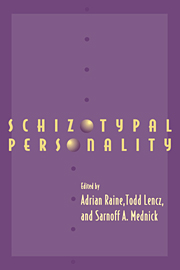Book contents
- Frontmatter
- Contents
- List of contributors
- Preface
- Acknowledgments
- Part I Introduction
- Part II Genetics and neurodevelopment
- Part III Assessment
- Part IV Categorical versus dimensional approaches
- Part V Psychophysiology and psychopharmacology
- Part VI Neuropsychology
- Part VII Brain imaging
- Part VIII Conclusion
- Part IX Appendix
- Semistructured interviews for the measurement of schizotypal personality
- Name Index
- Subject Index
Semistructured interviews for the measurement of schizotypal personality
from Part IX - Appendix
Published online by Cambridge University Press: 04 August 2010
- Frontmatter
- Contents
- List of contributors
- Preface
- Acknowledgments
- Part I Introduction
- Part II Genetics and neurodevelopment
- Part III Assessment
- Part IV Categorical versus dimensional approaches
- Part V Psychophysiology and psychopharmacology
- Part VI Neuropsychology
- Part VII Brain imaging
- Part VIII Conclusion
- Part IX Appendix
- Semistructured interviews for the measurement of schizotypal personality
- Name Index
- Subject Index
Summary
It has been 15 years since the introduction of schizotypal personality disorder (SPD) as an official diagnostic entity in DSM-III (APA, 1980). In that time, a number of semistructured clinical interviews have been developed to assess for SPD. These interviews serve to complement the self-report instruments reviewed by Chapman et al. (Chapter 5, this volume); the clinical interview schedules, while significantly more time consuming, were designed in order to obtain more detailed and potentially more accurate information than self-report instruments. Specifically, the use of clinical interviews attempts to overcome false negatives related to a lack of self-awareness or defensiveness, as well as false positives due to misunderstanding on the part of subjects of the requirement that symptoms be longstanding.
In addition to these purposes, the observations of the interviewer can be used to rate directly the presence of schizotypal signs, which are supposed to be evident to an outside observer, as opposed to symptoms, which are problems reported by the subject. The three observable schizotypal signs listed in DSM-III-R (APA, 1987) include constricted or inappropriate affect, odd speech, and odd appearance or behavior. It should be noted that the ratings of the other six SPD symptoms in clinical interviews are based on “self-report,” although this term is usually applied to paper-and-pencil questionnaires (Loranger, 1992). However, clinical interview measures allow the diagnostician to follow up on the subject's self-report, and to assess whether the subject properly understands the question – for example, by asking for concrete details or anecdotes. In this way, clinical interview measures have the potential to increase greatly the validity of clinical diagnosis.
- Type
- Chapter
- Information
- Schizotypal Personality , pp. 463 - 480Publisher: Cambridge University PressPrint publication year: 1995
- 2
- Cited by

